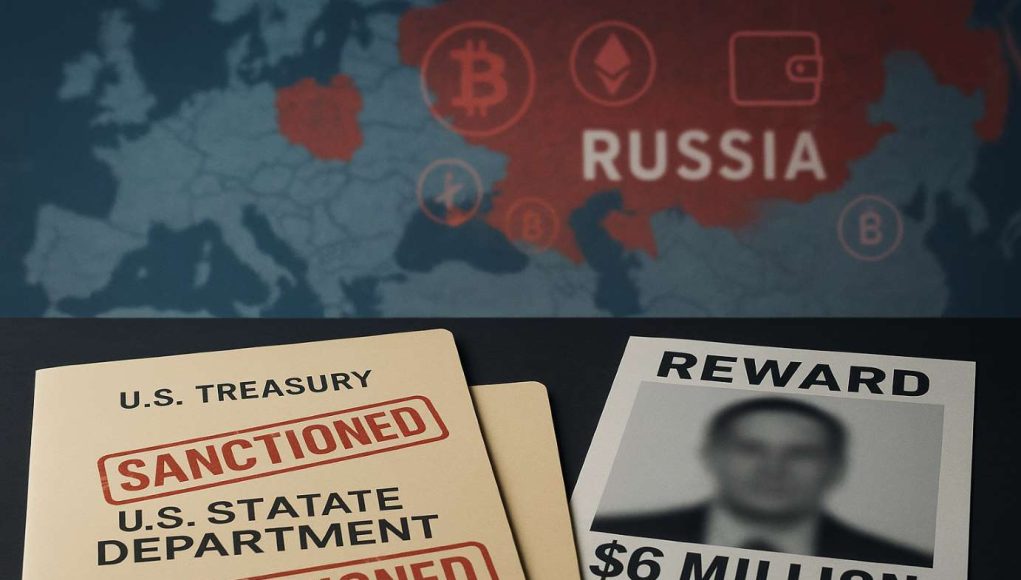The United States has intensified its campaign against illicit Russian cryptocurrency activity. It re-designated Garantex under new sanctions and blacklisted its alleged successor Grinex. The U.S. State Department also announced a $6 million bounty for information leading to the arrest or conviction of Garantex’s leadership. Authorities say both exchanges played a central role in ransomware laundering and darknet market transactions. These activities violate U.S. sanctions enforced by the Treasury’s Office of Foreign Assets Control (OFAC) against cryptocurrency exchanges.
Garantex’s Troubled History
Founded in Moscow, Garantex operated as a major trading hub for ruble-denominated digital assets. The platform was first sanctioned in 2022 after U.S. investigators linked it to more than $100 million in illicit transactions. These included payments tied to ransomware groups like Ryuk and Conti. Hydra and other darknet marketplaces also used the exchange.
According to the U.S. Treasury’s Office of Foreign Assets Control (OFAC), Garantex acted as a gateway for converting cryptocurrency from criminal activities into fiat currency. This undermined global sanctions enforcement.
>>> Read more: Crypto Sanctions: U.S. Targets Houthi Wallets
Grinex: The Alleged Successor
The newly sanctioned Grinex exchange is accused of acting as a contingency plan crypto exchange for Garantex. Investigators say it inherited its infrastructure, user base, and operational methods. OFAC alleges that Grinex continued the same illicit services while bypassing restrictions from earlier sanctions. The case shows how sanctions are evaded through rebranded entities that look legitimate but are run by the same individuals or networks.
The $6 Million Garantex Bounty
In a parallel move, the State Department’s Rewards for Justice program is offering a bounty of up to $6 million for credible information on Garantex leadership. The reward applies to tips leading to arrest, conviction, or disruption of the network. Similar bounties have been used in past cybercrime cases. They have helped target ransomware operators and their enablers. Washington says the measure underscores its determination to dismantle these ecosystems.
Cybercrime and Ransomware Disruption
Exchanges like Garantex and Grinex serve as financial lifelines for ransomware operations. Victims often pay attackers in cryptocurrency. That money is then routed through such platforms to obscure its origin.
These exchanges help criminals launder ransomware payments through cryptocurrency channels, converting them into cash without alerting traditional banking systems. U.S. authorities believe that cutting off these laundering channels is critical to disrupting major ransomware operations.
Sanctions Policy and Compliance Risks
The re-designation of Garantex highlights OFAC’s approach to tightening enforcement through follow-up action, targeting sanctioned entities that continue operations. The inclusion of Grinex sends a warning to the industry that successor exchanges are not beyond reach.
The Treasury also sanctioned wallets tied to a ruble-backed stablecoin known as the A7A5 token, citing its role in sanctions evasion. For legitimate crypto businesses, this reinforces the need for robust sanctions compliance programs to avoid engagement with blacklisted counterparties.
>>> Read more: Russia Crypto Shift Archives
Global and Industry Reactions
There has been no public response from Russian authorities. Compliance experts say the measures will likely limit these exchanges’ access to international liquidity. Some exchanges outside Russia may now review their exposure to ruble-linked assets and reassess their customer due diligence processes.
The move signals to other jurisdictions that the U.S. won’t shy away from taking aggressive action against cross-border sanctions evasion through crypto schemes.
What’s Next
Officials say investigations into both exchanges are ongoing. More sanctions could follow against connected wallets, mixers, or service providers. Analysts warn that the same operators may attempt to launch another replacement platform. This makes vigilance essential.
The broader strategy, combining direct enforcement with financial isolation, will likely remain central to U.S. cybercrime policy.
>>> Read more: Embargo Ransomware: BlackCat Successor Targets Healthcare
The coordinated targeting of Garantex and Grinex marks a decisive escalation in U.S. efforts to curb illicit crypto flows linked to Russia. By coupling financial isolation through Garantex sanctions with a multi-million-dollar bounty on its leadership, Washington sends a clear message. The infrastructure that enables cybercrime and disruption will face relentless pressure, no matter how many times it changes its name.
Readers’ frequently asked questions
How can someone provide information to claim the $6 million bounty?
Tips can be submitted through the U.S. State Department’s Rewards for Justice secure online form or via regional U.S. embassy contacts. The program also offers channels for encrypted or anonymous communication.
What are the potential consequences for foreign exchanges that process transactions linked to sanctioned entities?
Such exchanges risk being added to OFAC’s Specially Designated Nationals (SDN) list, which can cut them off from the U.S. financial system, limit their international partnerships, and expose them to secondary sanctions.
How do investigators link successor exchanges like Grinex to previously sanctioned platforms?
Authorities use blockchain forensics, transaction pattern analysis, shared infrastructure identifiers (like wallet clusters), and intelligence from cooperating jurisdictions to trace operational continuity between entities.
What Is In It For You? Action items you might want to consider
Review your exchange’s compliance protocols
If you operate or trade through a crypto exchange, ensure it has robust sanctions screening tools in place to block transactions involving OFAC-listed entities and wallet addresses.
Monitor OFAC updates and SDN list changes
Stay informed on the U.S. Treasury’s sanctions announcements, especially new additions to the Specially Designated Nationals list, to avoid indirect exposure to blacklisted platforms.
Use blockchain analytics to assess counterparty risk
Leverage blockchain intelligence services to identify links between counterparties and sanctioned entities, including potential successor exchanges attempting to evade restrictions.











[…] >>> Read more: U.S. Sanctions Garantex & Grinex, Offers $6M Bounty […]